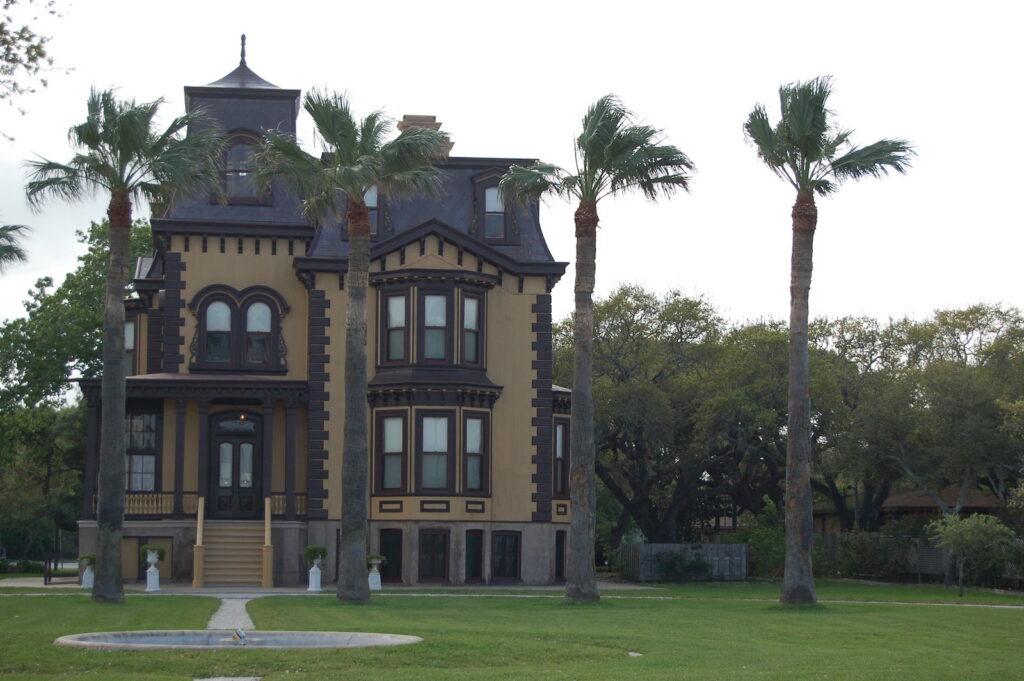The Fulton Mansion State Historic Site

Nestled along the Texas Gulf Coast, the Fulton Mansion State Historic Site stands as an emblem of 19th-century opulence and design. Built from 1874 to 1877 by entrepreneur George Ware Fulton and his wife Harriet Smith Fulton, the mansion boasts a rich history and is a testament to coastal living during that era. Its architectural brilliance reflects French Second Empire influences, distinguished by its mansard roof and ornate detailing, which were innovative for Texas at that time and signal a bygone era of architectural grandeur.
The mansion’s significance extends beyond its unique design; it holds the story of the Fultons, a family whose lives mirrored the economic growth and cultural changes of late 19th-century Texas. The interior of the home, preserved and restored to reflect the Fultons’ lifestyle, offers visitors an authentic experience of the period’s domestic life. From elegantly furnished parlors to the state-of-the-art conveniences of the time, including indoor plumbing and a gas lighting system, the home reveals the blend of tradition and innovation characteristic of the era.
Cared for now as a public treasure, the Fulton Mansion has undergone extensive preservation efforts, safeguarding this jewel of history for future generations to appreciate. The site serves not only as a museum for period artifacts and a center for education on local history but also as a venue that encapsulates the essence of living along the Texas coast in the 1800s. It allows visitors to step back in time and immerse themselves in the storied past of the mansion and its inhabitants.
The History of Fulton Mansion
The Fulton Mansion State Historic Site offers visitors insight into affluent coastal living during the 19th century, showcasing a distinctive architectural style and the family narrative of its original inhabitants.
Origins and Construction
Constructed between 1874 and 1877, the Fulton Mansion stands as a testament to opulent 19th-century residential architecture in coastal Texas. The mansion was built by George Ware Fulton and his wife Harriet Gillette Fulton, utilizing innovative building techniques uncommon for its time. Notable elements featured in its construction include:
- Structural Materials: The mansion was primarily built using local materials such as shellcrete, a type of concrete made from shells.
- Design Features: It flaunted a French Second Empire architectural style, notable for its mansard roof and ornate detailing.
The Fulton Family Saga
The lives of the Fulton family are etched into the very walls of the mansion. They were prominent figures, deeply involved in developing the Texas Gulf Coast region during the late 19th century. Key aspects of their story include:
- George Ware Fulton: An industrialist, engineer, and inventor, George played a pivotal role in the development of the local meatpacking industry and in land colonization projects.
- Harriet Gillette Fulton: Harriet was integral to the establishment of a school and church in the Rockport area, signifying the family’s commitment to community development.
Architectural Significance
The Fulton Mansion State Historic Site stands out as a testament to architectural prowess and progressive design in the 19th century, marking a distinct transition in building styles and living standards on the Texas Gulf Coast.
Design and Innovation
The mansion, completed in 1877, showcases advanced architectural features uncommon in that era, particularly in coastal Texas. Its overall style is a blend of French Second Empire architecture and local traditions. Notably, the house is constructed with a sturdy shell, employing balloon frame construction, a technique involving the use of light wooden frames, which was innovative for its time and an anomaly in a region prone to strong storms.
Inside, the Fulton Mansion is equally remarkable. It was one of the first homes in the area to be equipped with indoor plumbing, featuring conveniences such as flush toilets and gas lighting. The mansion also boasted a central heating system, which utilized warm air rising from the basement level, indicating a level of engineering sophistication that was ahead of its times.
Cultural Influence
The architectural significance of the Fulton Mansion extends beyond its innovation. The building’s design reflects the status and cultural outlook of its original inhabitants, George and Harriet Fulton. The ornate exteriors and interiors indicated wealth and a desire to emulate the contemporary European styles of the time, signaling their social standing.
The mansion also played a role in setting architectural trends in the region. Its distinct appearance and advanced features had a cultural impact on the surrounding area, inspiring local builders and architects to adopt similar design elements in their own projects. Today, the Fulton Mansion is a crucial piece in understanding the cultural and architectural heritage of the Texas Gulf Coast.
Lifestyle of the 19th Century Coastal Elite
The 19th century coastal elite enjoyed a lifestyle that reflected their social status and wealth, from their day-to-day activities to their opulent social functions.
Day-to-Day Life
- Morning routines: They usually began with personal grooming, followed by a breakfast that included imported teas and local delicacies.
- Daily activities: Men tended to business matters or estate management, while women oversaw the household and engaged in leisure activities such as reading or embroidery.
- Attire: Dressing was an elaborate affair with different outfits for various daytime activities; attire was a significant indicator of social status.
Social Functions
- Gatherings: They hosted and attended grand parties, balls, and dinners, often with meticulous planning and formal invitations.
- Entertainment: Music, dance and card games were vital in entertaining guests, alongside lavish spreads of food and drink.
- Estate as a venue: Their homes, like the Fulton Mansion, served as the center for these elaborate social gatherings and were a testament to their prosperity and taste.

Transformation into a Historic Site
In 1976, the Fulton Mansion was officially designated as a historic site. This transition marked the beginning of its second life, providing the public a window into the late 19th century coastal lifestyle.
Preservation Efforts
Ownership Transfer: In 1971, the mansion was purchased by the Texas Parks and Wildlife Department. Restoration Process: Significant restoration focused on authenticity, involving:
- Repairs to the ornate woodwork and masonry
- Reconstruction of the distinctive mansard roof
- Updating of the internal systems to ensure safety and accessibility
Mansion as a Museum
Public Opening: After restoration, Fulton Mansion opened its doors to the public as a museum. Exhibits and Tours: Visitors can explore:
- Original Victorian furnishings and artworks
- Informative displays detailing the Fulton family’s history and their era
- Guided tours that underscore the architectural and historical significance of the site
Visitor Experience
Those who visit the Fulton Mansion State Historic Site are treated to engaging tours and informative programs which illuminate the life and times along the Texas Gulf Coast during the 19th century.
Tours and Programmes
Visitors to the Fulton Mansion can choose from a variety of tour options. Self-guided tours allow guests to explore at their own pace, with informative plaques and a mobile tour app providing historical context. Alternatively, guided tours are offered by knowledgeable docents who share intriguing anecdotes about the mansion’s past. The site also hosts special events and programs throughout the year, including holiday-themed tours and historical reenactments that bring the mansion and its stories to life.
- Self-guided Tours: Explore at leisure with mobile app assistance
- Guided Tours: Led by expert docents
- Special Events: Seasonal and thematic programs available
Community and Education
The Fulton Mansion is not only a destination for history enthusiasts but also serves as an educational hub for the community. School programs are carefully crafted to align with curriculum standards and provide students a hands-on experience of history. Workshops and lectures catered to the general public cover various topics related to the mansion, its restoration, and historical preservation. The site actively engages with local organizations to promote cultural awareness and appreciation for the region’s heritage.
- School Programs: Educational field trips aligned with standards
- Public Lectures: Workshops and talks on restoration and preservation
- Community Engagement: Collaborations with local cultural groups



